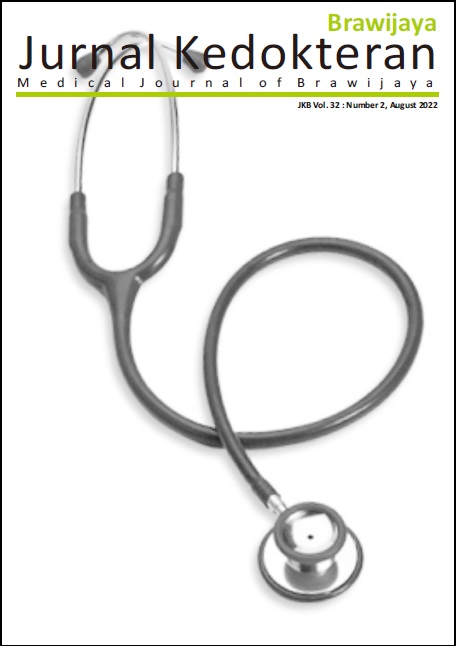A Two-Year-Old Boy with Diphallia and Multiple Congenital Anomalies: A Case Report
DOI:
https://doi.org/10.21776/ub.jkb.2022.032.02.10Keywords:
Diphallia, multiple anomaliesAbstract
Diphallia is a rare urogenital defect and varies from a small accessory penis or duplication of the glans to complete penile duplication. Its incidence is 1 in 5.5 million live births. Only 100 cases were reported from 1609 until 2021. A two-year-old boy with diphallia and multiple congenital anomalies had an uncircumcised penis with two glans penis and two complete urethral orifices, accompanied by scrotum bifidum, asymmetric right buttock, with normal anorectal position. Spina bifida with lipomyelocele, tethered cord at the level of vertebra lumbar 3-4, scrotum bifidum, and left mild hydronephrosis were observed using Magnetic Resonance Imaging (MRI). Urethrocystoscopy of both complete urethra revealed meatal stenosis and bulbar urethral stricture, normal posterior urethral, and no verumontanum in the right urethral orifice and did dilatation. Whereas normal urethral orifice, anterior urethra, posterior urethra and verumontanum were found in the left side. Management for diphallia must consider associated anomalies and the goal of patient satisfaction. In this case, conservative treatment is the best choice.
Downloads
References
Frolov A, Tan Y, Rana MW, and Martin III JR. A Rare Case of Human Diphallia Associated with Hypospadias. Case Reports in Urology. 2018; 2018: 1-6
Bhat HS, Sukumar S, Nair TB, and C. Saheed SM. Successful Surgical Correction of True Diphallia, Scrotal Duplication, and Associated Hypospadias. Journal of Pediatric Surgery. 2006; 41(10): 13-14.
Maharani TK. (Online) 2013. Faktor-Faktor yang Berpengaruh terhadap Kejadian Kelainan Kongenital Sistem Urogenital pada Neonatus. https://media.neliti.com/media/publications/112788-ID-faktor-faktor-yang-berpengaruh-terhadap.pdf diakses pada 23 Mei 2019
Mirshemirani AR, Sadeghyian N, Mohajerzadeh L, Molayee H, and Ghaffari P. Diphallus: Report on Six Cases and Review of the Literature. Iranian Journal of Pediatrics. 2010; 20(3): 353-357.
Gyftopoulos K, Wolffenbuttel KP, and Nijman RJM. Clinical and Embryologic Aspects of Penile Duplication and Associated Anomalies. Urology. 2002: 60(4): 675–679.
Torres ME, Sanchez PJC, Aragon TA, Camacho TV, and Colorado GA. Diphallia. Revista Mexicana de Urolog´ıa. 2009; 69(1): 32–35.
Mandal A dan Sahi PK. Complete Diphallus. BAOJ Pediatrics. 2017; 3(2): 1-3
Acimi S. Complete Diphallia. Scandinavian Journal of Urology and Nephrology. 2008; 38(5): 389-391.
Kouka SCN, Diallo Y, Millogo S, et al. Penile Duplication: A Case Report. Medical & Surgical Urology. 2016; 5(1): 1-2
Levin T, Han B, and Little BP. Congenital Anomalies of the Male Urethra. Pediatrics Radiology. 2007; 37(9): 851-862.
Sharma N, Gupta S, Goyal M, and Sattavan S. Complete Diphallia with No Other Associated Congenital Anomaly. International Journal of Medical Pediatrics and Oncology. 2017; 3(3): 136-136
Warf BC, Scott MR, Barnes PD, and Hendren III WH. Tethered Spinal Cord in Patients with Anorectal and Urogenital Malformations. Pediatric Neurosurgeon. 1993; 19(1): 25-30.
Downloads
Published
Versions
- 2022-11-04 (2)
- 2022-08-31 (1)
Issue
Section
License
Authors who publish with this journal agree to the following terms:- Authors retain copyright and grant the journal right of first publication with the work simultaneously licensed under a Creative Commons Attribution License that allows others to share the work with an acknowledgement of the work's authorship and initial publication in this journal.
- Authors are able to enter into separate, additional contractual arrangements for the non-exclusive distribution of the journal's published version of the work (e.g., post it to an institutional repository or publish it in a book), with an acknowledgement of its initial publication in this journal.
- Authors are permitted and encouraged to post their work online (e.g., in institutional repositories or on their website) prior to and during the submission process, as it can lead to productive exchanges, as well as earlier and greater citation of published work (See The Effect of Open Access).














